#lesbian feminist history
Text

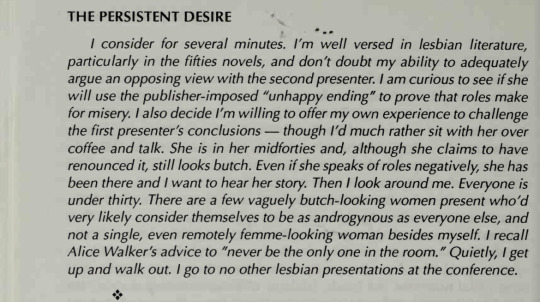
"The main justification for invalidating butch-femme is that its an imitation of heterosexual roles and, therefore, not a genuine lesbian model. One is tempted to react by saying "So what?" but the charge encompasses more than betrayal of an assumed fixed and "true" lesbian culture. Implicit in the accusation is the denial of cultural agency to lesbians, of the ability to shape and reshape symbols into new meanings of identification. Plagiarism, as the adage goes, is basic to all culture.
In the real of cultural identity, that some of the markers of a minority culture's boundaries originate in an oppressing culture is neither unusual nor particularly significant. For instance, in the United States certain kind of bead- and ribbon work are immediately recogniziable as specific to Native American cultures, wherein they serve artistic and ceremonial functions. Yet beads, trinkets, ribbons, and even certain "indian" blanket patterns were brought by Europeans, who traded them as cheap goods for land. No one argues that Indians out to give up beadwork or blanket weaving, thus ridding themselves of the oppressors symbols, because those things took on a radically different cultural meaning in the hands of Native Americans. Or consider Yiddish, one of the jewish languages. Although Yiddish is written in Hebrew characters and has its own idioms and nuances, its vocabulary is predominantly German. Those who speak German can understand Yiddish. Genocidal Germanic anti-Semitism dates back to at least the eleventh century. Yet East European Jews spoke "the oppressors language," developing in it a distinctive literary and theatrical tradition. Why is it so inconceivable that lesbians could take elements of heterosexual sex roles and remake them?
*
It is June 1987, and I am sitting in a workshop on "Lesbians and Gender Roles" at the annual National Women's Studies Conference. It is one of surprisingly few workshops on lesbian issues, particularly since, at a plenary session two mornings later, two thirds of the conference attendees will stand up as lesbians. Meanwhile, in this workshop the first speaker is spending half an hour on what she calls "Feminism 101," a description of heterosexual sex roles. Her point in doing this, she says, is to remind us of the origin of roles, "which are called butch and femme when lesbians engage in them." She tells us the purpose of her talk will be to prove, from her own experience, that "these roles are not fulfilling" for lesbians. She tells us that the second speaker will use lesbian novels from the 1950s to demonstrate the same thesis. And, indeed, the second speaker has a small stack of 1950s "pulp paperbacks" with her, many of them the titles that, when I discovered them in the mind-1970s, resonated for me in a way that the feminist books published by Daughters and Diana Press did not.
I consider for several minutes. I'm well versed in lesbian literature, particularly in the fifties novels, and don't doubt my ability to adequately argue an opposing view with the second presenter. I am curious to see if she will use the publisher-imposed "unhappy ending" to prove that roles make for misery. I also decide I'm willing to offer my own experience to challenge the first presenters conclusions- though I'd much rather sit with her over coffee and talk. She is in her midforties and, although she claims to have renounced it, still looks butch. Even if she speaks of roles negatively, she has been there and I want to hear her story. Then I look around me. Everyone is under thirty. There are a few vaguely butch-looking women present who'd very likely consider themselves to be as androgynous as everyone else, and not a single, even remotely femme-looking women besides myself. I recall Alice Walker's advice to "never be the only one in the room." Quietly, I get up and walk out. I go to no other lesbian presentations at the conference."
“Recollecting History, Renaming Lives: Femme Stigma and the feminist seventies and eighties" by Lyndall MacCowan, The Persistent Desire, (edited by Joan Nestle) (1992)
#the persistent desire#Lyndall MacCowan#Joan nestle#lesbian#lesbianism#butch and femme#butchfemme#butch and femme history#butch lesbian#femme lesbian#butch history#femme history#lesbian history#lesbian culture#lesbian feminism#lesbian feminist history#lgbt history#queer history
90 notes
·
View notes
Text
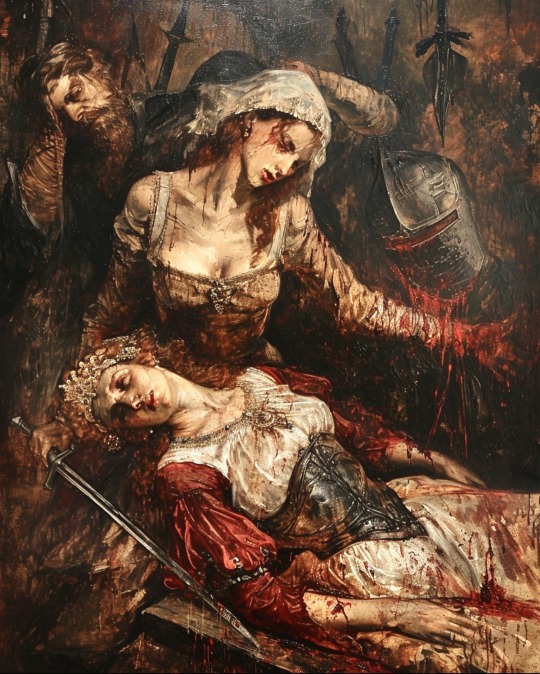
© Breed My Darkness
#painting#art#artblr#art history#oil on canvas#oil painting#classical art#goth#femme#gothic#wlw#lesbian#strong female character#feminist#feminine#dark feminine aesthetic#dark feminine energy#classic academia#dark academia#artist#art community#art gallery#art blog
3K notes
·
View notes
Text
Would you go down and give me head?💦🤫
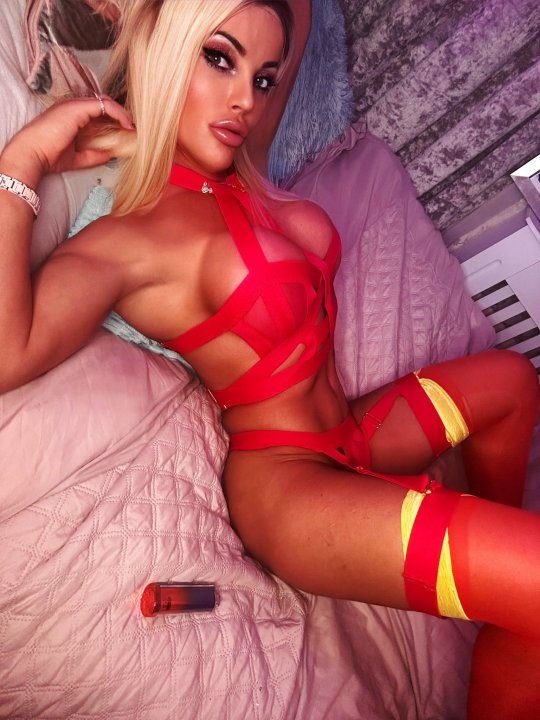
#trans history#trans healthcare#trans gwen stacy#trans headcanon#trans hrt#trans joy#trans lesbian#trans love#trans man#trans people#trans self ship#trans uk#trans selfie#trans positivity#trans sex worker#trans sissy#trans solidarity#trans shitposting#trans story#trans streamer#transgender#trans mtf#trans youth#trans logic#trans exclusionary radical feminist#trans weight gain#trans dad#trans dating#transgiri#trans k!nk
906 notes
·
View notes
Text
My university history course literature includes a book on women's history. Entirely written by two men. It has a whole chapter on "transgender history". The first person they bring up is Ulrika Eleonora Stålhammar, a swedish woman from the late 17th- early 18th century who started dressing as a man and took a male name to marry her wife Maria Lönman. After ten years or so she started presenting herself as a woman again. These men are SO confused as to why. Why would she ever stop living as a man? And if she was a lesbian, why bother living as a man in the first place, considering female homosexuality was never formally outlawed in Sweden? The entire time they refer to her as a trans man.
Why oh why could a woman in the 18th century possibly be uncomfortable living as a woman? Why oh why would a woman in the 18th century not just live openly as a lesbian? What reason could she POSSIBLY have had to pretend to be a man? Nah, no critical thinking here. She was obviously a man all along, that's the only reasonable explanation. This is what they're making university students read for history.
Stop discrediting these brave women. I know you think you're being inclusive and progressive by imagining they were Actually trans, but you're not. All you're doing is perpetuating the myth that all women are and were submissive and content in their role as second class citizens (if even that). If every female person who was gender nonconforming in the Olden Times was actually a man all along then the actual women didn't have it that bad, right? They never rebelled against their societal roles before the women's voting right movements, right??
1K notes
·
View notes
Text
when i say “i can’t talk right now, i’m doing hot girl shit.” what i really mean is “i can’t talk right now, i’m doing my bio hw while listening to classical music and pretending i’m a female scientist in the 1700s learning in secret using books i stole from the academy when they refused to let me in, i’m hiding away in the attic of the opera house (where i work) while the orchestra rehearses beneath me. they’ll never accept me in the world of academia, but i know i’m destined for greatness.”
#study motivation#studyblr#college#acedemic#dark acedemia#light acedemia#history nerd#history#feminist#maladaptive daydreaming#romance books#bookworm#booklr#bio major#meme#adhd#adhd meme#lesbian#funny#love#mental health#positivity#cottagecore#autism#wlw
3K notes
·
View notes
Text
Happy Pride Month! To kick off pride I'm busting some myths about the Stonewall Riots, Marsha P. Johnson, and giving some love and recognition to Stormé DeLarverie!




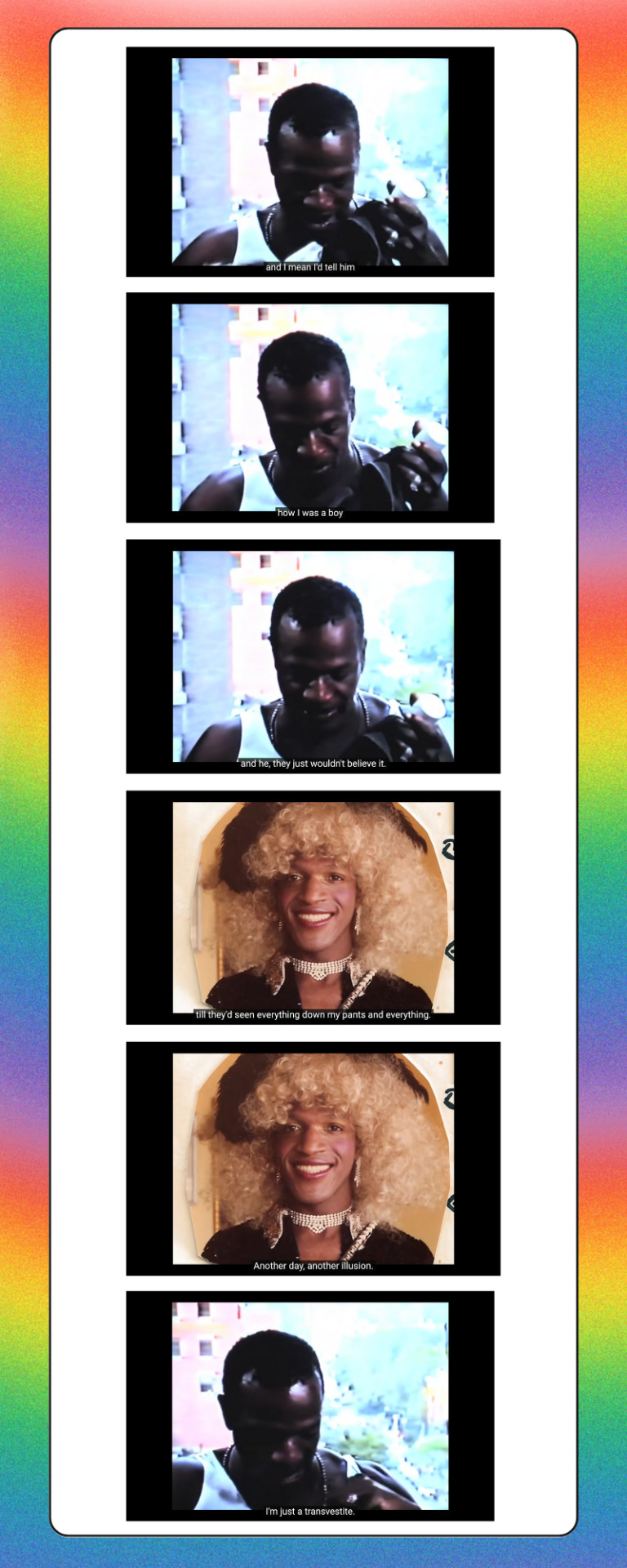

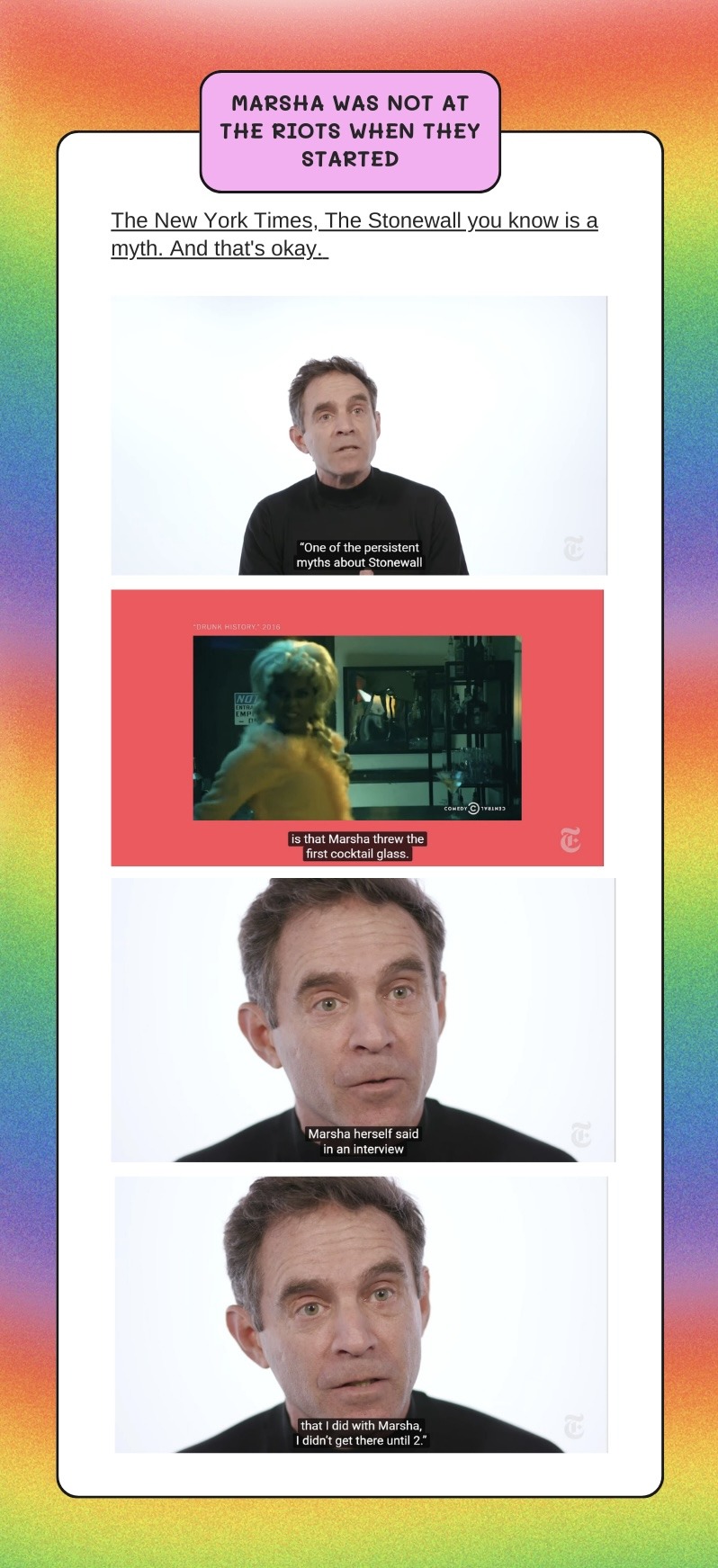
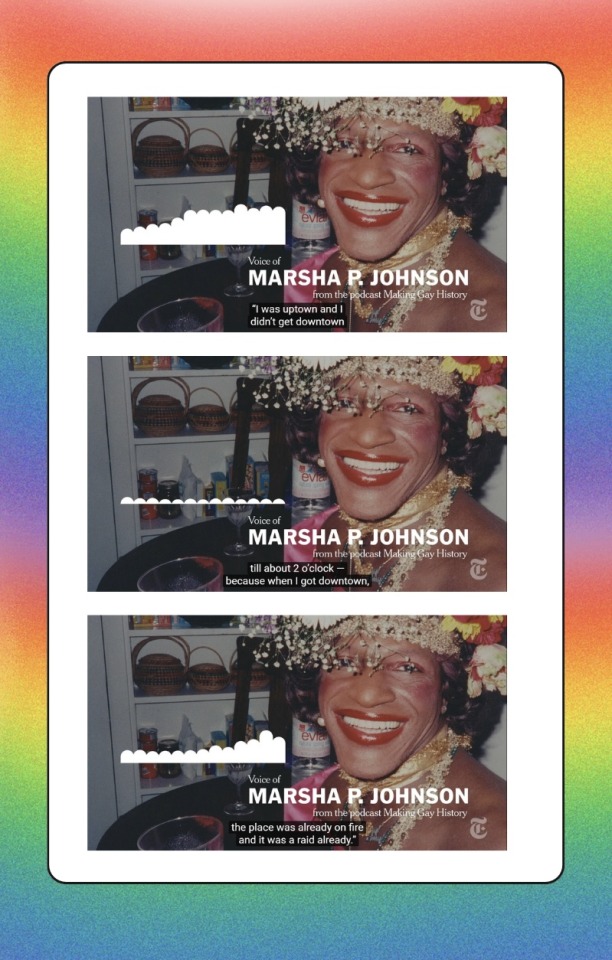


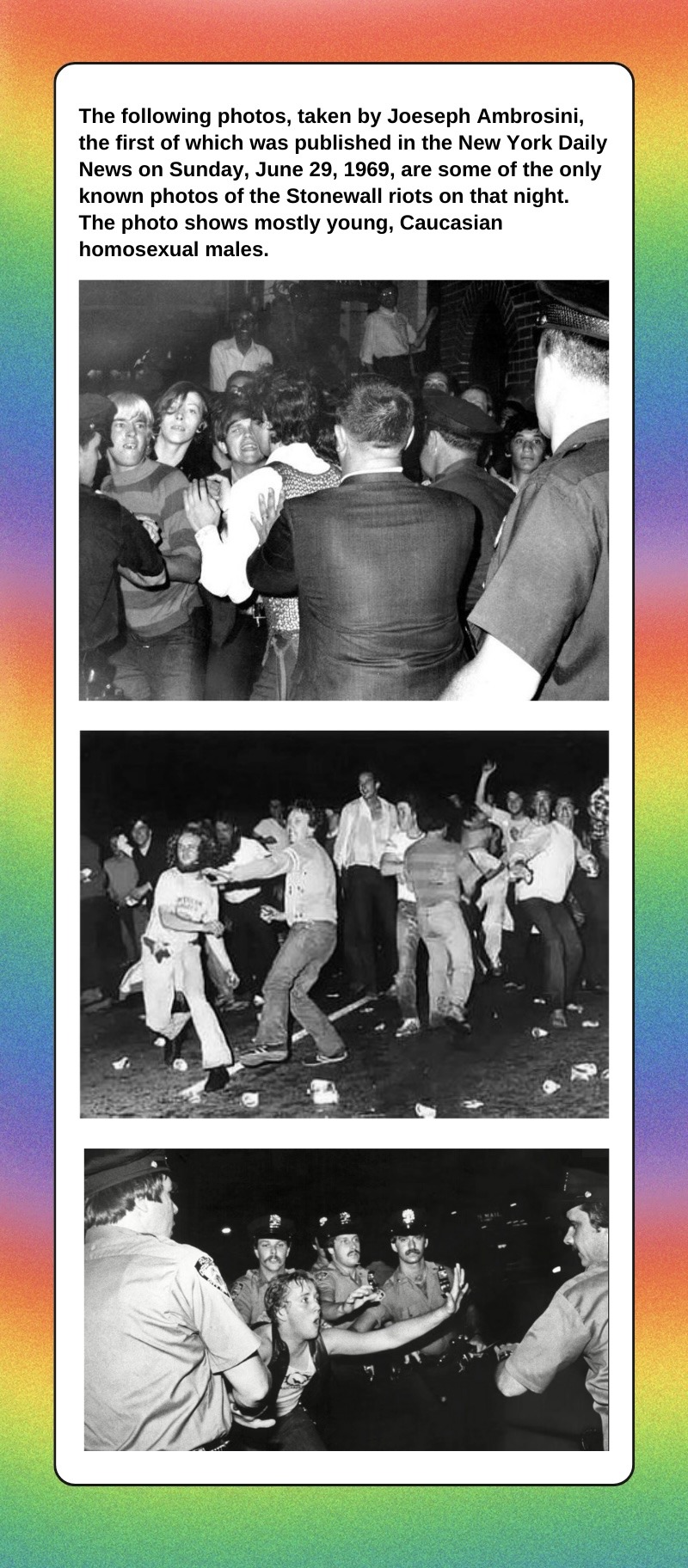
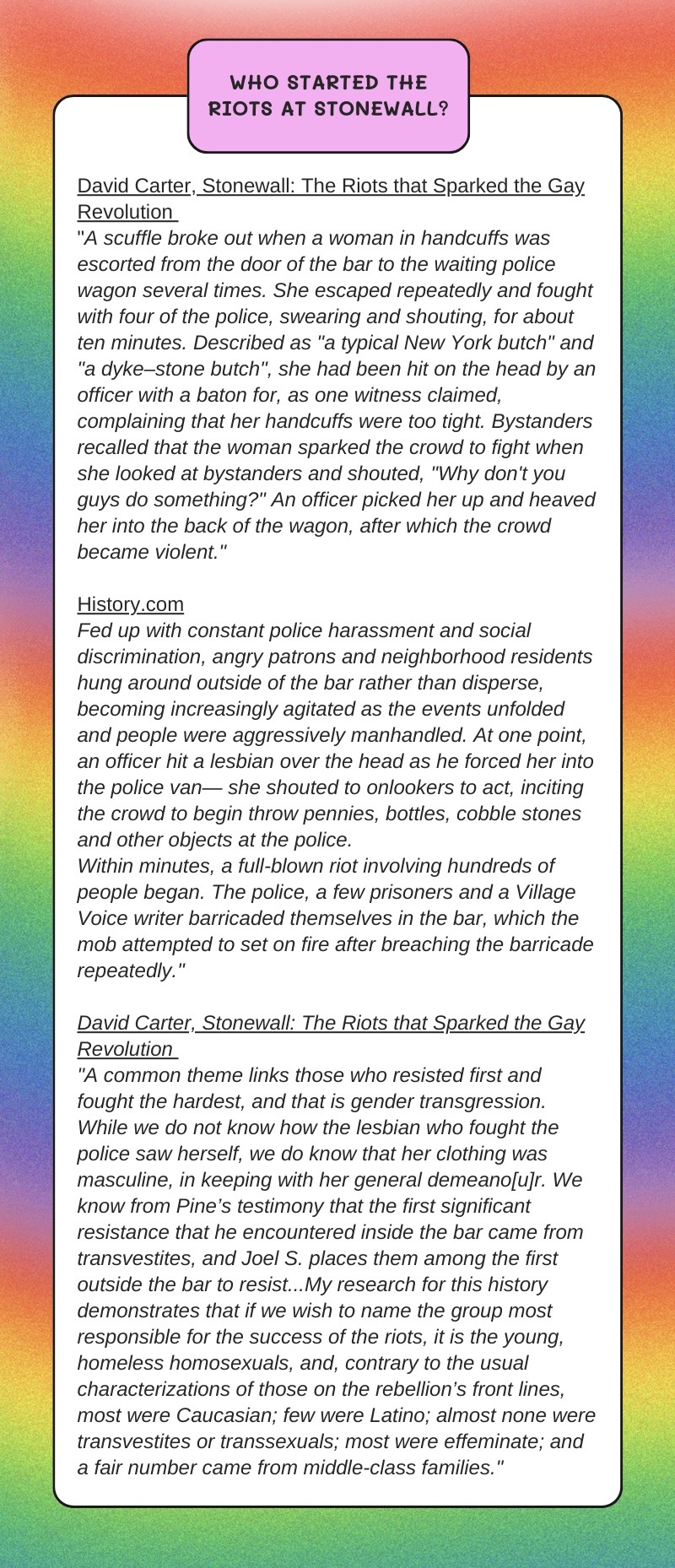
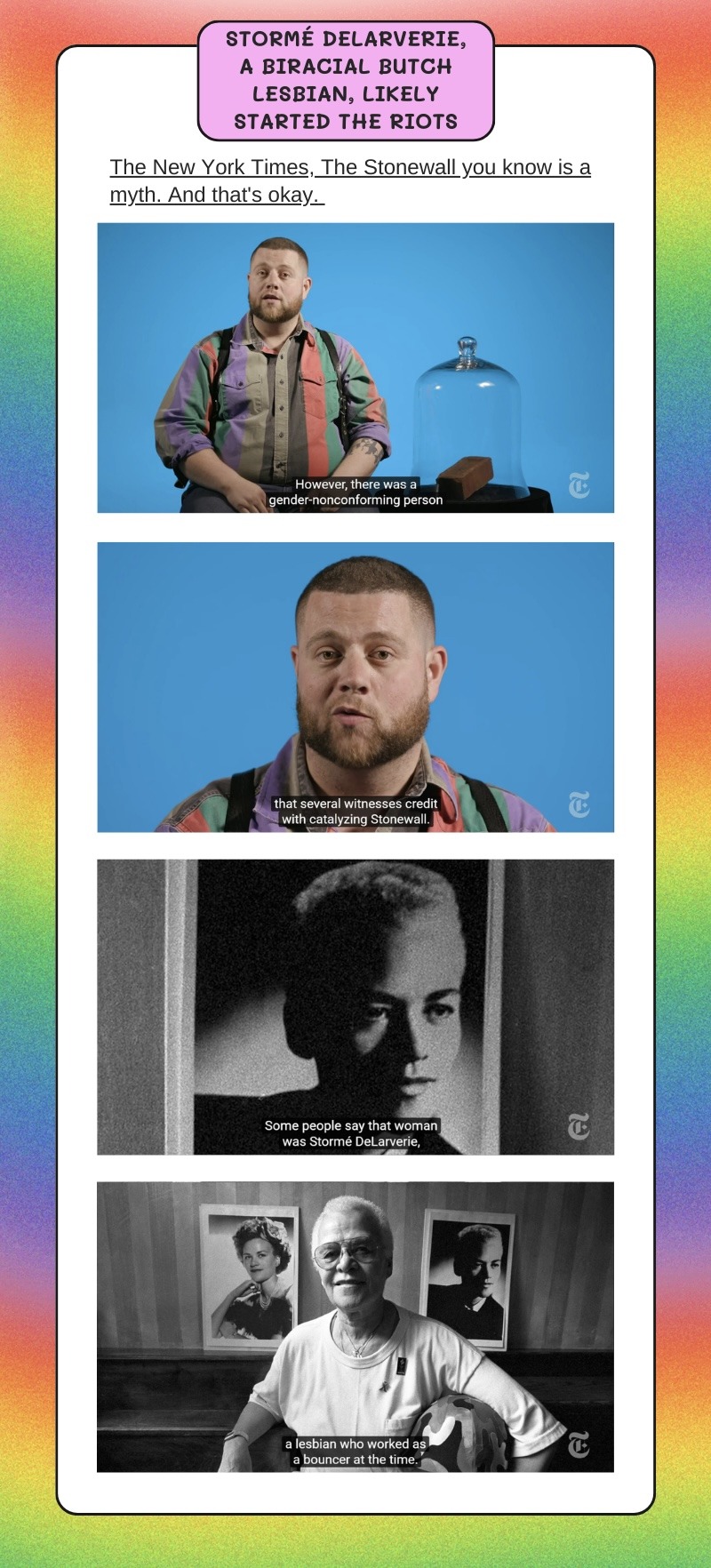
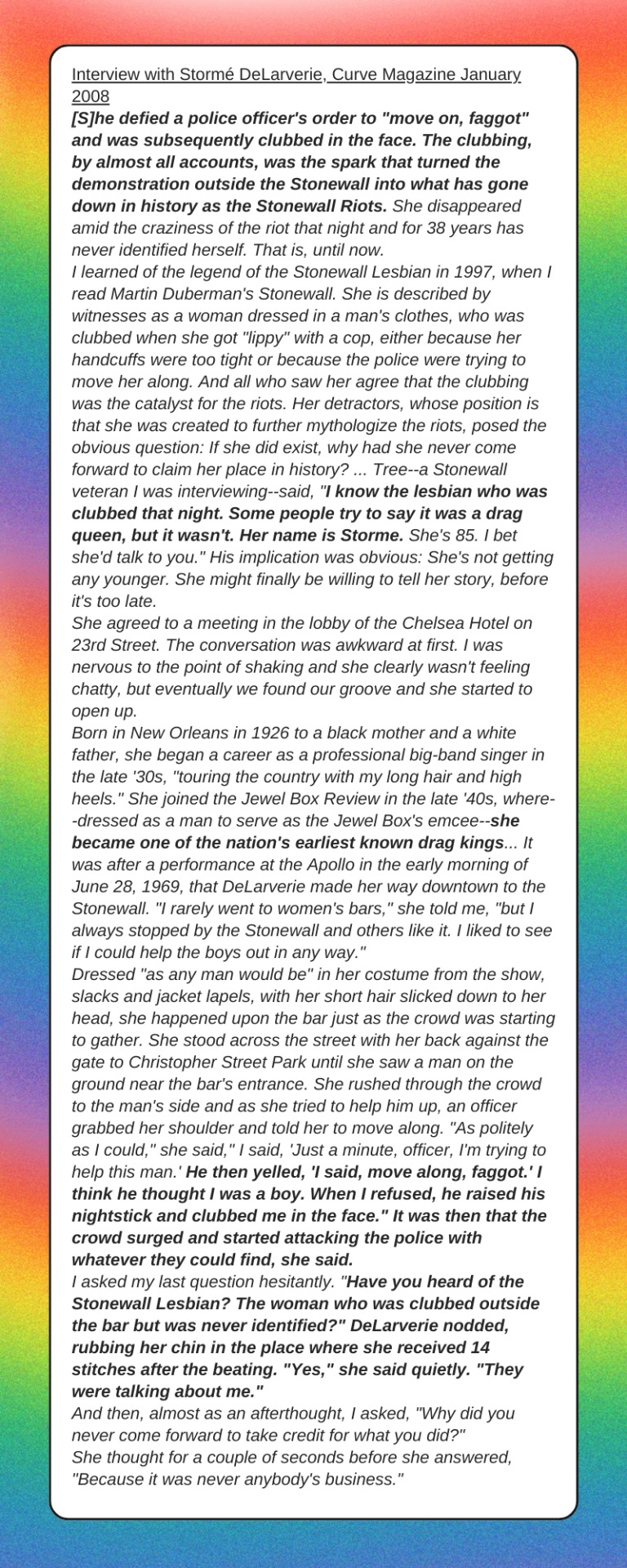
This was sitting unfinished for months but I got it together and completed it in time for pride.
Edit (6/12/23): I believe only the first Joseph Ambrosini photo was confirmed to be taken the first night of the Stonewall riots; I couldn't find sources that indicated if the other photos were taken on that same night or not.
#gender abolition#w4w post#w4w infographic#feminism#feminist#lgb#lgbt#pride#stonewall#marsha p johnson#storme delarverie#lgb history#lgbt history#gay rights#gay history#lesbian#w4w lgb
763 notes
·
View notes
Text


Zofia Sadowska (deceased)
Gender: Female
Sexuality: Lesbian
DOB: 28 February 1887
RIP: 7 March 1960
Ethnicity: White - Polish
Occupation: Doctor, activist, feminist
Note: In 1914, she was the first woman and the first Polish woman to defend her doctorate.
#Zofia Sadowska#lgbt history#lgbt#lgbtq#lesbian history#female#lesbian#1887#rip#historical#white#polish#doctor#activist#feminist#first#popular#popular post
210 notes
·
View notes
Text
It's concerning that this is now an LGB and women's issue now, but I really encourage people to begin purchasing USB drives or external hard drives and saving digital research on things such as gay & lesbian history, screenshots of tweets that might be important, homosexual and bisexual research, women's history, radical feminist books or PDFs, and really just anything that is at risk of being "corrected" by gender ideology or made inaccessible by academic publishers.
We need to save these things in a hard copy format as opposed to just using internet archive or taking Sci-hub for granted, because these organizations are experiencing heavy lawsuits. Additionally, it's becoming common for LGB and gender nonconformity history and research to be "rewritten" by gender ideologists. Actually, this is even true for past research and history on transvestism and transsexualism, too, in addition to things such as sex dysphoria, etc.
I bought three 64GB USBs for just $25. If you can't afford an external hardrive, buy some different colored USBs and start building your own library. We need to preserve this information and decentralize it as much as possible. It's worrisome enough that we rely on digital archives this much just generally, especially with the advent of AI and government and corporate attempts to eliminate data privacy and control.
This is a women's rights issue and an LGB issue now.
#human rights#LGB#LGBT#gay history#protect gay history#women's history#women's rights#LGBT history#gender critical#radical feminist#dataprotection#data protection#references#resources#activism#gay activism#lesbian culture#lesbian rights#lesbian history#gay rights#adult human female#feminism
997 notes
·
View notes
Text
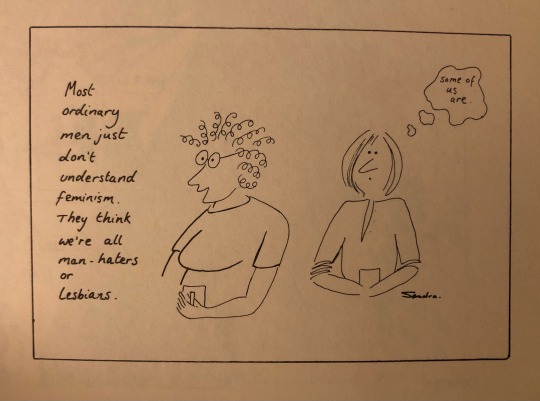
Source: Women Draw 1984 - art by Sandra Warne
#feminist#feminisim#lesbian history#lavender menace#lesbian art#lesbian comic#image#lgbt#photo#lesbian#art#perosnal
1K notes
·
View notes
Text

from Country Lesbians: The Story of Womanshare Collective
they were just like us!
#female separatism#hopefem#women's land#lesbian#lesbian history#lesbians#radical feminist safe#radical feminists do interact#radblr#sisterhood
220 notes
·
View notes
Text

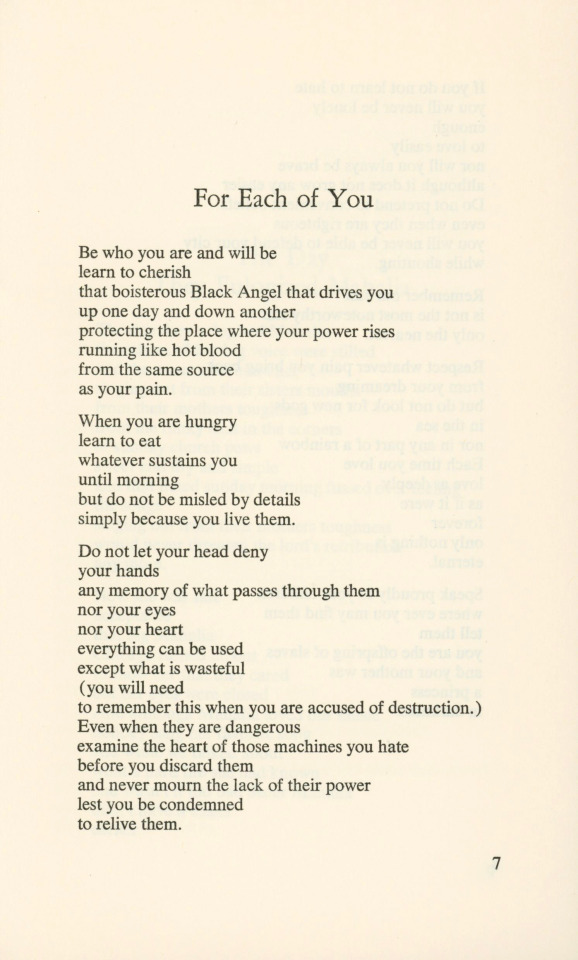




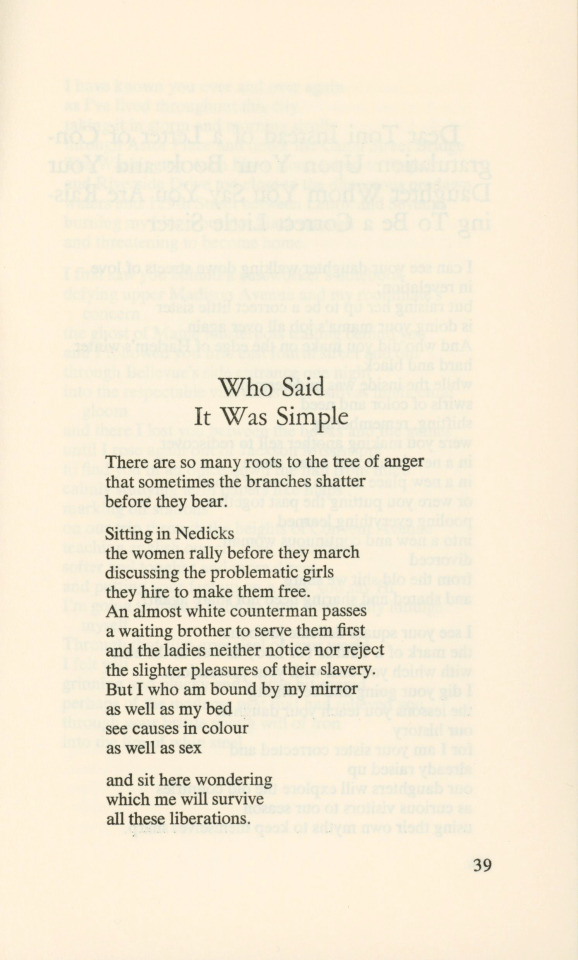



International Women's Day
In celebration of Women’s History Month and International Women’s Day (March 8), we’re showcasing one of writer, educator, intersectional feminist, poet, civil rights activist, and former New York public school librarian Audre Lorde’s (1934–1992) early collections of poetry. From a Land Where Other People Live was published in 1973 by Detroit’s groundbreaking Broadside Press. This independent press was founded in 1965 by poet, University of Detroit librarian, and Detroit’s first poet laureate Dudley Randall (1914-2000) with the mission to publish the leading African American poetry of the time in a well-designed format that was also "accessible to the widest possible audience." A comprehensive catalog of Broadside Press’s impressive roster of artists (including Gwendolyn Brooks, Nikki Giovanni, and Alice Walker, to name a few), titled Broadside Authors and Artists: An Illustrated Biographical Directory, was published in 1974 by educator and fellow University of Detroit librarian Leaonead Pack Drain-Bailey (1906-1983).
Lorde described herself in an interview with Callaloo Literary Journal in 1990 as “a Black, Lesbian, Feminist, warrior, poet, mother doing [her] work”. She dedicated her life to “confronting and addressing injustices of racism, sexism, classism, and homophobia.” From a Land Where Other People Live is a powerfully intimate expression of her personal struggles with identity and her deeply rooted critiques of social injustice. The work was nominated for the National Book Award for poetry in 1974, the same year that Broadside Press published New York Head Shop and Museum, another volume of Lorde’s poetry featured in our collection. You can find more information on her writings and on the organization inspired by her life and work by visiting The Audre Lorde Project.
More posts on Broadside Press publications
More Women’s History Month posts
More International Women’s Day posts
-- Ana, Special Collections Graduate Fieldworker
#Women’s History Month#International Women’s Day#Audre Lorde#Broadside Press#Dudley Randall#Detroit#Poetry#From a Land Where Other People Live#Independent presses#Feminist writers#Lesbian writers#Black writers#women writers#women poets#Ana
99 notes
·
View notes
Text
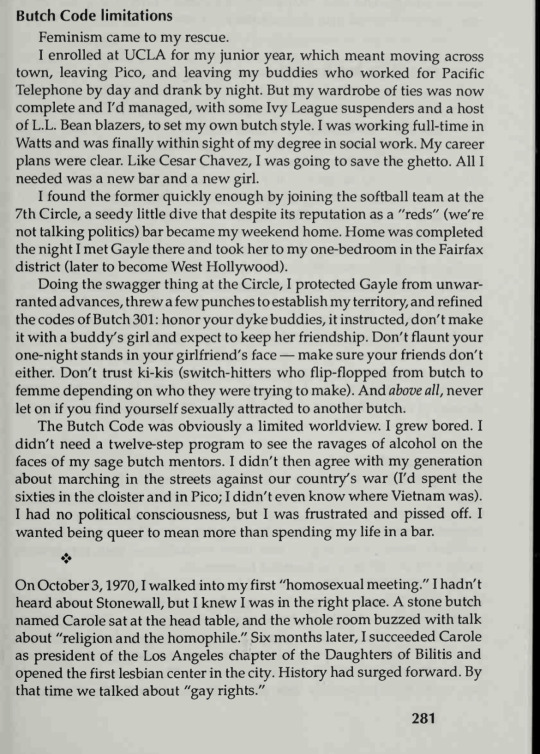

"Butch Code Limitations
Feminism came to my rescue.
I enrolled at UCLA for my junior year, which meant moving across town, leaving Pico, and leaving my buddies who worked for Pacific Telephone by day and drank by night. But my wardrobe of ties was now complete and I'd managed, with some Ivy League suspenders and a host of L.L. Bean blazers, to set my own butch style. I was working full-time in Watts and was finally within sight of my degree in social work. My career plans were clear. Like Cesar Chavez, I was going to save the ghetto. All I needed was a new bar and a new girl.
I found the former quickly enough by joining the softball team at the 7th Circle, a seedy little dive that despite its reputation as a "reds" (we're not talking politics) bar became my weekend home. Home was completed the night I met Gayle there and took her to my one-bedroom in the Fairfax district (later to become West Hollywood).
Doing the swagger thing at the Circle, I protected Gayle from unwaranted advances, threw a few punches to establish my territory, and refined the codes of Butch 301: honor your dyke buddies, it instructed, don't make it with a buddy's girl and expect to keep her friendship. Don't flaunt your one-night stands in your girlfriend's face -- make sure your friends don't either. Don't trust ki-kis (switch-hitters who flip-flopped from butch to femme depending on who they were trying to make). And above all, never let on if you find yourself sexually attracted to another butch.
The butch code was obviously a limited worldview. I grew bored. I didn't need a twelve-step program to see the ravages of alchol on the faces of my sage butch mentors. i didn't then agree with my generation about marching in the streets against our country's war (I'd spend the sixties in the cloister and in Pico; I didn't even know where Vietnam was). I had no political consciousness, but I was frustrated pissed off. I wanted being queer to mean more than spending my life in a bar.
On October 3, 1970 I walked into my first homosexual meeting. I hadn't heard about Stonewall, but I knew I was in the right place. A stone butch name Carole sat at the head table, and the whole room buzzed with talk about "religion and the homophile." Six months later, I succeeded and Carole as president of the Los Angeles chapter of the Daughters of Bilitis and opened the first center in the city. History had surged forward. By that time we talked about "gay rights."
One day I found a leaflet crammed in the mailbox of our DOB Center. It was from another organized group of gay girls, the Lesbian-Feminists. I'd heard about them through the dyke grapevine. No one knew what their name meant, they were reported to be "weirdos," and they were known to hang out at a center for women. This sounded ominous, but the leaflet gave an address and said, "All women welcome." I decided queer unity must prevail; I would visit their territory.
Feminism and the Butch Closet
It was not love at first sight. Listening to my "sisters" that first night was one of the most disorienting experiences of my life. These women forbade use of the word girl. No one flirted with anyone. No one even asked my name, much less noticed my new wing tips. The Lesbian-Feminists did nothing but talk for five hours. And they weren't even discussing an outing or anything tangible. They were spouting some convoluted religious. It had to be religious, because they were all intensely righteous. I thought I knew about the religions of the world, but this was a new one. Apparently it was also very ancient, because one of them proclaimed their "matriarchy" was as "old as history itself."
By midnight I was convinced I'd received the wrong information. These girls weren't lesbians. There were no butches. Many of them looked vaguely feminine, in the hippie style of the day. A clunky sandal seemed to be their shoe of choice, but none of them wore makeup. I knew no bona fide femme would go out in public without makeup or heels.
Concluding that they were some kind of crackpot sect, I rose to leave. As I stomped across the wood floor, enjoying how the chains on my boots clanged through their meanderings, the one called "Radical Rita Right On" shouted at me, "What kind of lesbian are you?"
-“Butches, Lies, and Feminism" by Jeanne Cordova, The Persistent Desire, (edited by Joan Nestle) (1992)
#the persistent desire#Jeanne Cordova#lesbian#lesbianism#lesbian history#lesbian lit#gay rights history#lesbian feminism#lesbian feminist history#Butch lesbian#femme lesbian#butch lesbian history#lgbt#lgbtq+#gay rights
63 notes
·
View notes
Text
Time to learn about more people and things that influenced my politics~
The Combahee River Collective.
They were a Black feminist lesbian socialist organization active in Boston, Massachusetts from 1974 to 1980.
"The Collective argued that both the white feminist movement and the Civil Rights Movement were not addressing their particular needs as Black women and more specifically as Black lesbians.
Racism was present in the mainstream feminist movement, while Delaney and Manditch-Prottas argue that much of the Civil Rights Movement had a sexist and homophobic reputation."
The Collective is perhaps best known for developing the Combahee River Collective Statement, a key document in the history of contemporary Black feminism and the development of the concepts of identity politics as used among political organizers and social theorists, and for introducing the concept of interlocking systems of oppression, including but not limited to gender, race, and homophobia, a fundamental concept of intersectionality. Gerald Izenberg credits the 1977 Combahee statement with the first usage of the phrase "identity politics".
Source
Demita Frazier, Beverly Smith, and Barbara Smith were the primary authors of the Combahee River Collective Statement in 1977. [...]They sought to destroy what they felt were the related evils of capitalism, imperialism, and patriarchy while rejecting the belief in lesbian separatism. Finally their statement acknowledged the difficulties black women faced in their grassroots organizing efforts due to their multiple oppressions.
In “A Black Feminist’s Search for Sisterhood,” Michele Wallace arrives at this conclusion:
We exists as women who are Black who are feminists, each stranded for the moment, working independently because there is not yet an environment in this society remotely congenial to our struggle—because, being on the bottom, we would have to do what no one else has done: we would have to fight the world. [2]
Wallace is pessimistic but realistic in her assessment of Black feminists’ position, particularly in her allusion to the nearly classic isolation most of us face. We might use our position at the bottom, however, to make a clear leap into revolutionary action. If Black women were free, it would mean that everyone else would have to be free since our freedom would necessitate the destruction of all the systems of oppression.
#i think of that line at least twice a month#and this is why you will NEVER catch me not having solidarity with black women#combahee river collective#black feminism#black feminists#demita Frasier#Beverly smith#Barbara smith#black lesbians#queer history#lgbt History#black history#queer rights#lesbian rights#solidarity#identity politics#lgbt#capitalism#i should start recommending this as a starter too tbfh#queer#lesbian history#black women#black revolutionaries#lesbian revolutionaries#intersectionality#feminism#lesbian#patriarchy#white feminism#feminists
127 notes
·
View notes
Text
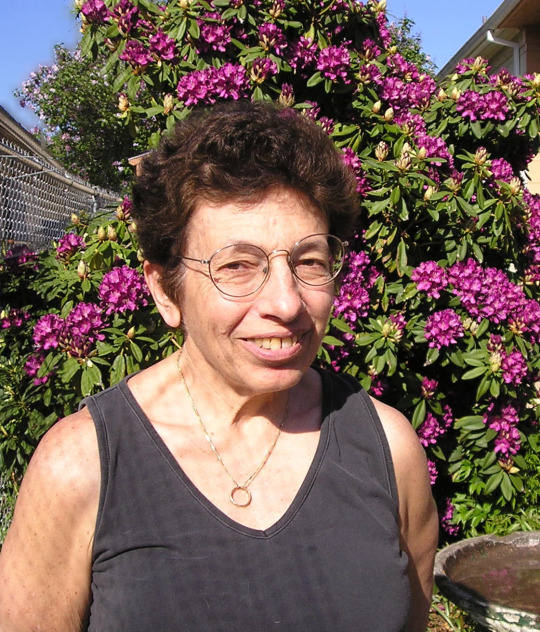
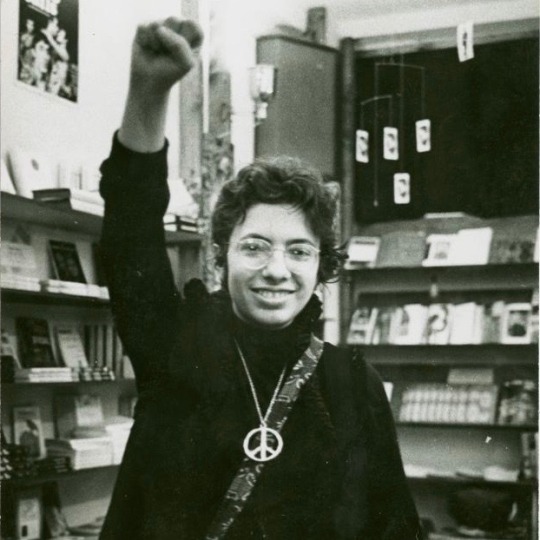
Martha Shelly is a Jewish activist lesbian and feminist.
She was involved in many forms of activism including the Vietnam anti war protests and was an ally to the Black Panthers. She joined the Daughters of Bilitis, a lesbian civil rights group, in 1967, and later went on to become president of the New York chapter. While working as a secretary in the office of fundraising for Barnard College, she joined the Student Homophile League.
After witnessing the Stonewall riots and seeing the public reaction Martha was inspired to organize a protest. With the DOB and the Mattachine Society they organized the first gay protest march in America, shortly after that, they formed the Gay Liberation Front. She became the face of the movement, going on tv programs and speaking at public events.
As a young adult her therapist put her through a conversation therapy of sorts, she insisted she try to be bisexual as to not “give up on half the world in her dating pool”. She tried for a while, getting with other gay men put in this program and went on to date bisexual activist Stephen Donaldson. But after her working with the GLF and getting more involved with her community she accepted herself as a lesbian.
At the time lesbians were considered a threat to the feminist movement. The president of The National Organization for Women Betty Friedan called lesbians in the movement a “lavender menace” and the organization distanced themselves from lesbian causes and even omitted the sponsorship of the DOB. Women from DOB and the GLF, including Martha, joined together to create the group ‘Lavender Menace’ in response. Together, dawning shirts and signs they protested at a NOW event for lesbian causes to be included.
My job was to jump up on the stage and grab the mic. I explained that we were here because lesbians had been excluded, and we wanted to talk about our issues. Then I put it to the audience. "Let's take a vote how many want to continue with the panel discussion? How many want to hear what we have to say?" The women voted overwhelmingly to hear from us. Then other Menaces marched down the aisle and stepped up onto the stage, while a few remained in the audience. A freewheeling discussion ensued. At their next annual conference NOW revised their platform to include lesbian rights.
The group was soon after renamed the Radicalesbians.
Despite members of the group partaking in it, Martha did not consider herself a lesbian separatist. She liked the idea of lesbian only spaces but thought that splitting the gay movement into smaller groups would weaken the movement as a whole.
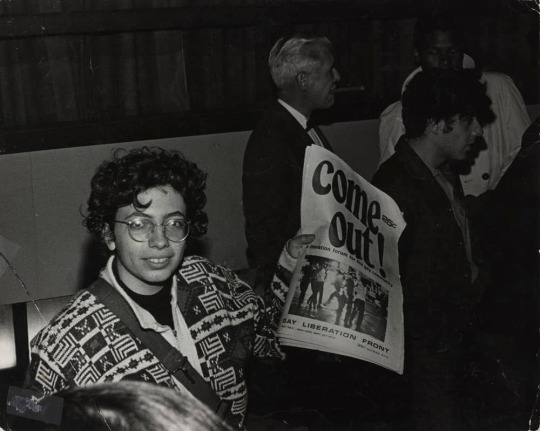
Sources:
We Set the Night on Fire: Igniting the Gay Revolution by Martha Shelley (2023)
Martha Shelley - Wikipedia
#martha shelley#lgbt history#lesbian history#queer history#feminist history#lesbianism#lgbt education#activists#people#feminism#lgbtq community#lesbians in action
117 notes
·
View notes
Text
History of lesbian flags and their meanings.
I’m going to explain the history behind lesbian flags and their meanings. I want to especially to educate about the labrys flag, as there is a lot of misinformation about this version of lesbian flag, such as that the author is a N*zi which isn’t true. English isn’t my first language, so I apologize if something doesn’t make sense.
Labrys flag
One of the earliest lesbian flags, designed in 1999 by a gay graphic designer Sean Campbell.

Meanings behind labrys flag:
Violet background
Color violet has been associated with lesbians since ancient greek times - violet flower is a symbol of lesbian love, which originates from Sappho’s poetry, where she described her lover as wearing a garland of flowers.
Inverted black triangle
N*zi concentration camps badges, mostly triangles, were used to identify the reason the prisoners had been placed there. Inverted black triangle was used for women who were “Asocial” (Asozial) and “Work-Shy” (Arbeitsscheu). Jewish, Romani, homeless, alcoholic, prostitute, lesbian women were the main victims. Lesbians decided to reclaim this symbol. Inverted black triangle is used in the flag to remember women who were victims of the n*zi camps.
Labrys
Labrys is a double axe that represents the strength and feminism of homosexual women. Lesbian community has been using labrys since 1970s. The labrys was the weapon of choice for the Amazons of Greek mythology, a group of female warriors and hunters whose society was closed to men.

Even though the inverted black triangle was reclaimed by lesbians, some people are still uncomfortable with the original version, that’s why they use version without the triangle.
Lipstick lesbian flag
Designed in 2010 by Natalie McCray in the weblog “This Lesbian Life”.

Lipstick mark
“Lipstick lesbian” is a slang for feminine lesbians, this term has been used since the 1980s, but gained popularity in the 1990s.
However, many people didn’t approve this flag, as it doesn’t include butches at all. People also refuse to use this lesbian flag due to the author being transphobic. 
Pink lesbian flag

It’s lipstick lesbian flag without the lipstick mark.
Sunset lesbian flag
Designed in 2018 by Emily Gwen on Tumblr.
Meaning behind the stripes
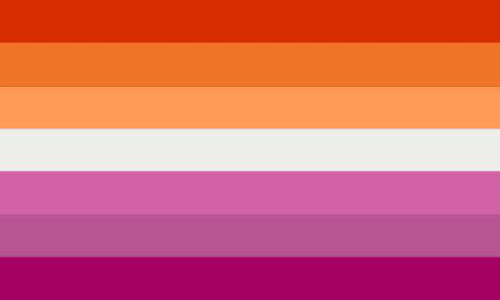
Dark Orange – Gender-non conformity
Coral orange – Independence
Light orange – Community
White – Unique relationship to womanhood
Pink – Serenity and Peace
Pastel pink – Love and Sex
Dark Pink – Femininity
Sunset version is the most commonly used version of the lesbian flag. Mostly due to the fact that this version is inclusive of trans and nonbinary lesbians.
Is there a “correct” lesbian flag?
No. Harassing someone, because they use labrys or lipstick/pink version of the flag instead of the sunset one is wasting your time and hurting someone for no valid reason.
Why some lesbians use the older versions of the lesbian flag?
Me and other lesbians who use labrys version of the lesbian flag instead of sunset one because labrys flag has actual history. In my opinion, the sunset lesbian flag is just aesthetically pleasing and has no actual powerful meaning unlike labrys version which represents lesbian history (violet background), remembers women who were victims of n*zi camps (inverted black triangle) and has symbol of strength and feminism of lesbianism (the labrys).
#radblr#radical feminism#radical feminist safe#radical feminists do interact#lesbian#lesbian flag#lesbian history
44 notes
·
View notes
Text

This is the woman who is going to tell me her story and everything about her life as a lesbian!! She told me she has been begging for someone to listen to her memories of lesbian culture, waiting for years for someone to listen and record and write it down!! And now someone (me) is excited to do that. This is incredible
#lesbian history#lesbians#New England lesbians#Atlanta history#lgbtq history#feminism#feminist history
28 notes
·
View notes